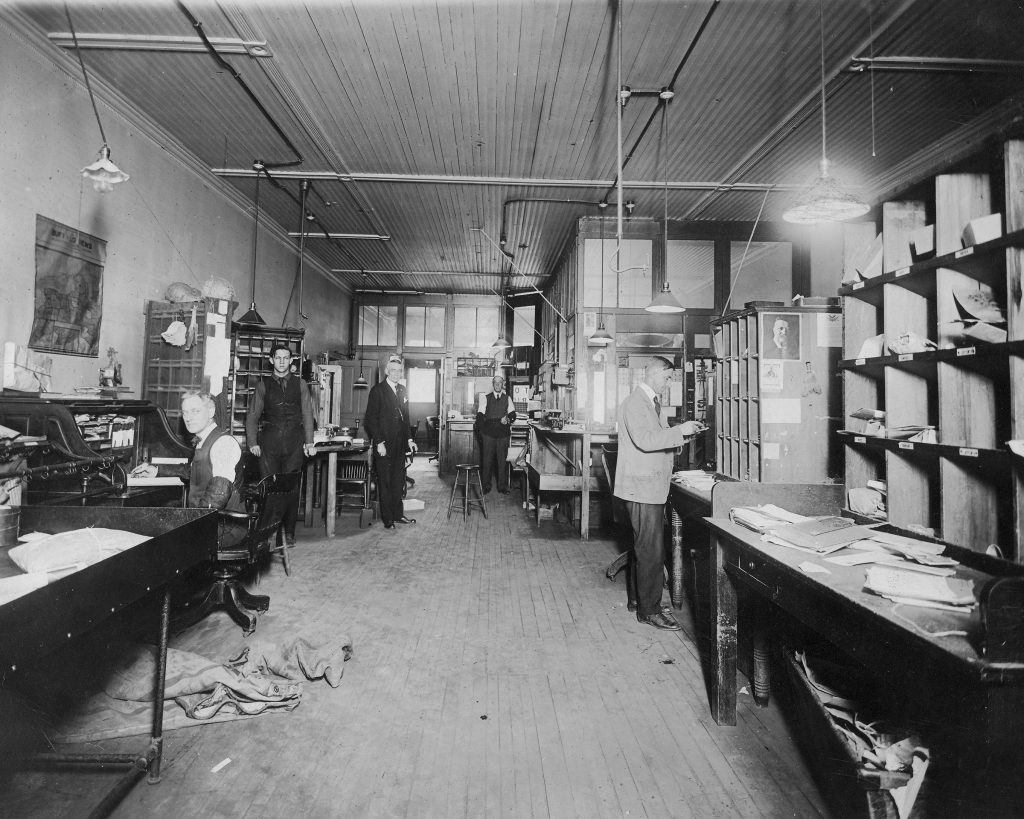
Volume 2, Issue 38
This image shows the interior of the Albion Post Office located near the intersection of East Bank and Platt streets. From left to right we see Frank Tripp, Leon Gilbert, Postmaster Daniel Hanley, an unknown gentleman, and Charles Patton. Note the image of Teddy Roosevelt hanging to the right; we also see scales situated on the back table used for weighing packages. Both Tripp and the gentleman standing in the background are wearing sleeves used to protect their shirts from wet pen ink.
During the earliest years of the U.S. Postal Service, the position of postmaster was one that was fueled by cronyism and serves as one of the finest examples of the patronage system. Many recommendations for local postmasters came from area congressmen who sought to appoint members of their affiliated party in exchange for political favors. For this reason, turnover for the position of postmaster was just as frequent as the state and national election cycles.
According to local papers, Albion experienced a taste of the patronage system when Robert Titus Coan was appointed to the position of postmaster in the early part of the 20th century. It was believed that his placement in the position stemmed largely from the recommendation of fellow Republican congressman James S. Wadsworth to then President William McKinley. Dating back to his appointment in 1898 the Orleans Republican noted, “The [Orleans] American certifies that R. Titus Coan is fit for the office of postmaster. How condescending!”
Several years later, the paper noted that Coan was simply a “tattler” and a “messenger boy” for Wadsworth who would be incapable of receiving ten votes if put up for election. Cries for his resignation came shortly after when Washington authorities prepared to push for his replacement due to charges of corruption and “pernicious political activity.” It was alleged that Coan encouraged the addition of mail clerks to the post office in place of acquiring machinery that would reduce operating costs and increase efficiency.
This particular image of the post office was taken around 1933 or 1934. We know that Daniel Hanley was appointed to replace Amelia Bartlett who occupied the post after the death of her husband Chester in August of 1933. The following year Leon Gilbert was transferred to the Knowlesville Post Office. Hanley was a former postmaster who lost his position when the Democrats lost control of the White House; he was also the former mayor of Albion.
In 1938 the new post office building was erected at Main and State streets at a cost of $52,000. The building replaced two homes once owned by village president Alexis Ward and local banker Alexander Stewart. Installed within the building was a hidden passageway that allowed for federal postal inspectors and the local postmaster to observe workers sorting mail. The superstitious Hanley, still postmaster at the time, placed pennies in all of the desk drawers for good luck before opening the building for the first time.
It was thanks to legislation passed by Presidents William Taft and Franklin D. Roosevelt that reduced corruption and brought an end to the role of the postmaster in the political patronage system.

